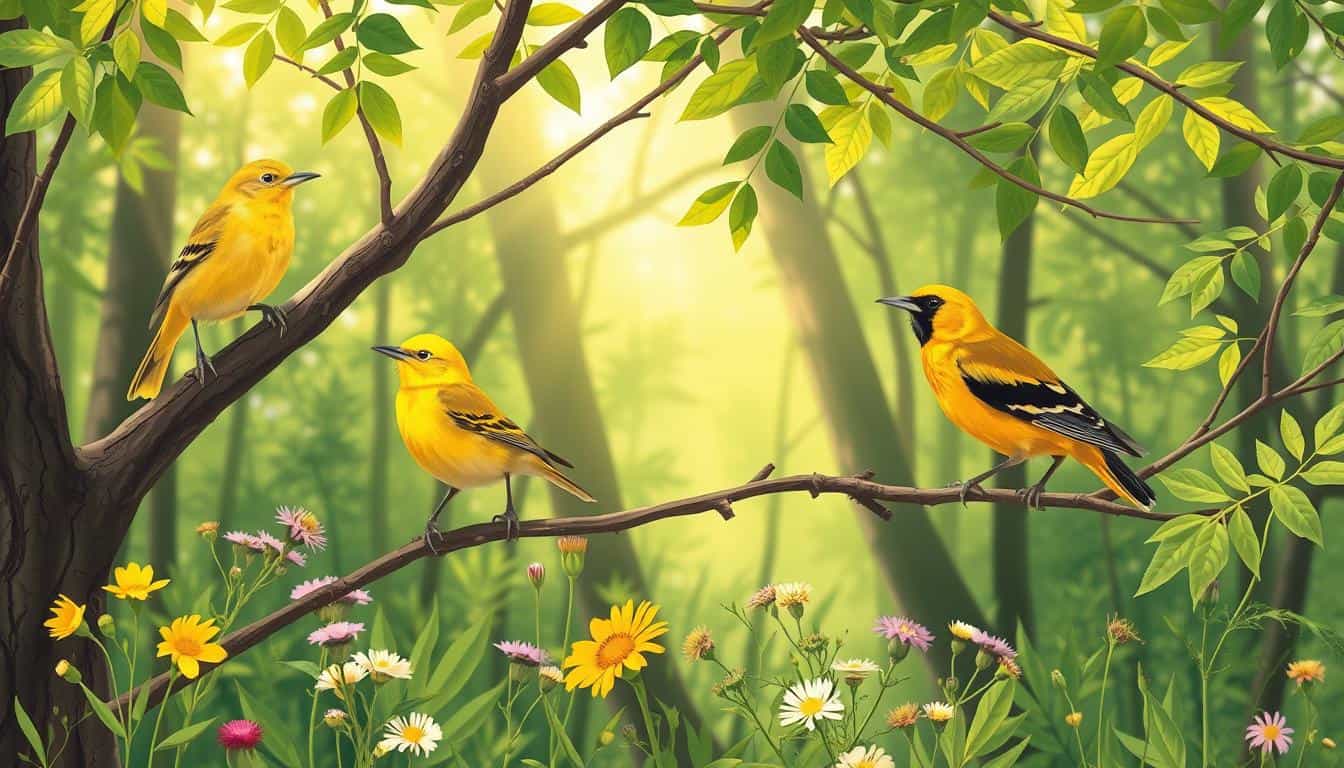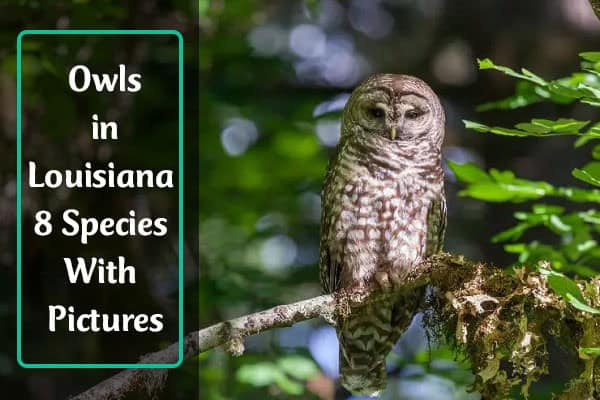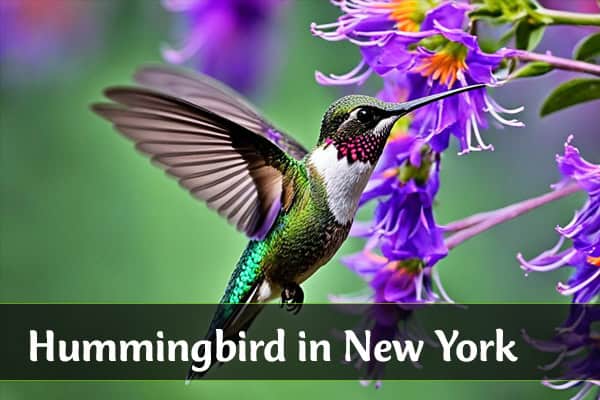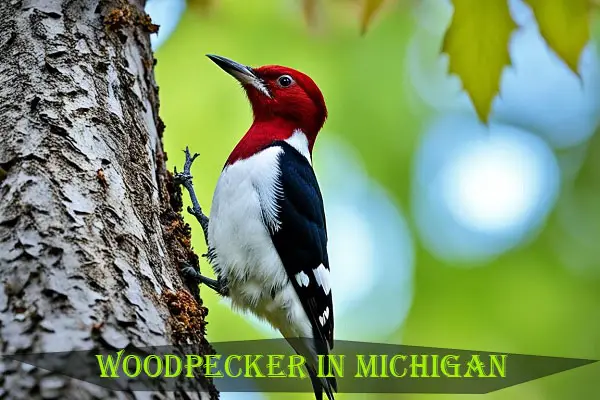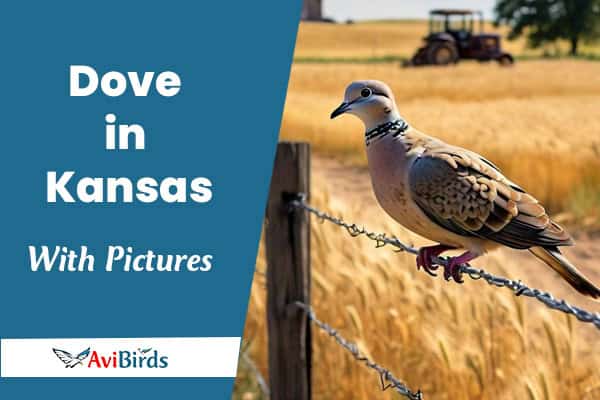12 Types of Yellow Birds Found in Colorado! (With Photos)
Did you know Colorado has over 12 kinds of yellow birds? These birds make the state’s landscape brighter and add to its biodiversity. The American Goldfinch is known for its bright yellow feathers. The Western Tanager is famous for its colors and songs.
We’ll look at the amazing yellow birds in Colorado. This includes the Wilson’s Warbler, known for its unique look and actions.
If you love birds or just enjoy watching them, this guide is for you. It will help you learn about the different yellow birds in Colorado. Each bird has its own special features and ways of living. You’ll find out about the Yellow Birds Found in Colorado that are not only beautiful but also important for the state’s nature.
Introduction to Yellow Birds in Colorado
Colorado is a great place for birdwatching, with over 500 bird species. Almost 20 of these have bright yellow feathers. These Yellow Birds add beauty to Colorado’s bird scene.
Spotting these birds is exciting. You might see a Yellow Warbler in bushes or a Yellow-breasted Chat singing. Each sighting is a chance to enjoy their beauty and learn about them.
Yellow birds make Colorado’s landscape more interesting. Birdwatchers love to watch their behaviors and where they live. It’s a fun challenge.
| Bird Species | Key Identification Features | Preferred Habitat |
|---|---|---|
| Lark Bunting | Striking coloring, male with black and white markings | Open grasslands |
| Lazuli Bunting | Brilliant blue with a chestnut belly | Pine forests, thickets |
| MacGillivray’s Warbler | Olive green with yellow underparts | Coniferous forests |
| Bullock’s Oriole | Male with bright orange and white wing patch | Open forests and urban areas |
| Yellow-Breasted Chat | Large songbird with bright yellow underparts | Thickets, shrublands |
| Eastern Towhee | Resembles a finch, but related to sparrows | Brushy areas |
| Bohemian Waxwing | Social birds, known for their soft plumage | Fruit-bearing trees, large groups |
| Curve-Billed Thrasher | Curved bill, gray plumage | Desert areas, prefers cacti |
| Mountain Bluebird | Striking blue color, smaller size | Open fields and grasslands |
1. American Goldfinch
The American Goldfinch, known as Spinus tristis, is a bright yellow bird in Colorado. Males turn yellow in summer, making them fun to watch. They have black caps and wings and look very striking.
In winter, both males and females turn brown or olive. This change shows how they adapt to the seasons.
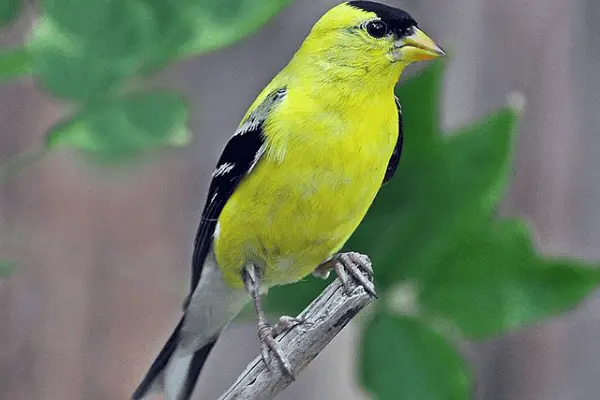
Identifying Characteristics
The American Goldfinch is known for its bright yellow feathers, especially in males. They also have a special song that helps you know they’re around. Females are less colourful but still have some yellow.
These signs help bird watchers spot the American Goldfinch easily.
Habitat and Diet
Goldfinches live in weedy areas and gardens. They like thistles, sunflowers, and other flowers for food. They build nests in shrubs or trees using plant materials.
They love places with lots of seeds. This helps them stay in Colorado all year, adding to the birding fun.
2. Western Tanager
The Western Tanager, known as Piranga ludoviciana, is a bird that lives in western forests. It has a bright yellow body and a red face, especially in males. Females are less colorful. Knowing how to spot them and where they go makes them even more interesting.
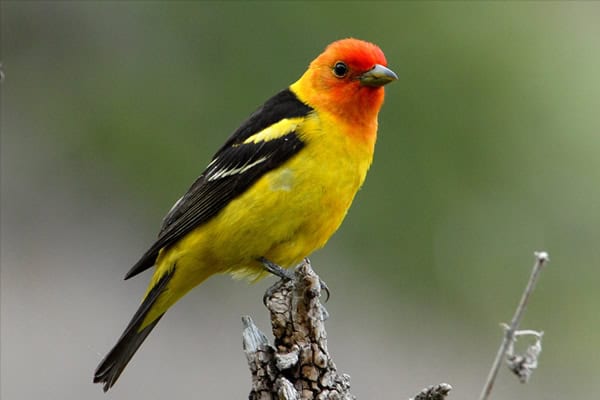
Identifying Features
Here’s what to look for when you see a Western Tanager:
- Adult males have an orange-red head, yellow body, and black wings.
- Females are yellowish with dark wings and two wingbars.
- Young males have yellow to patchy red heads and a scalloped back.
- They are 6.3-7.5 inches long and weigh 0.8-1.3 ounces.
- In the breeding season, they eat insects in trees.
Migration Patterns
Western Tanagers have interesting migration habits. They fly at night and like high places, traveling in small groups. You might see them with other tanagers or Black-headed Grosbeaks.
They come later in spring and leave sooner in fall. They breed far north, almost to 60°N in the Northwest Territories. In winter, they live in pine-oak woodlands and forest edges, looking for food until next spring.
3. Wilson’s Warbler
The Wilson’s Warbler, known as Cardellina pusilla, is one of the smallest warblers in the U.S. It has a greenish-yellow body and a black cap in males. This makes it very noticeable. In spring, males are very loud, showing off their special behaviours.
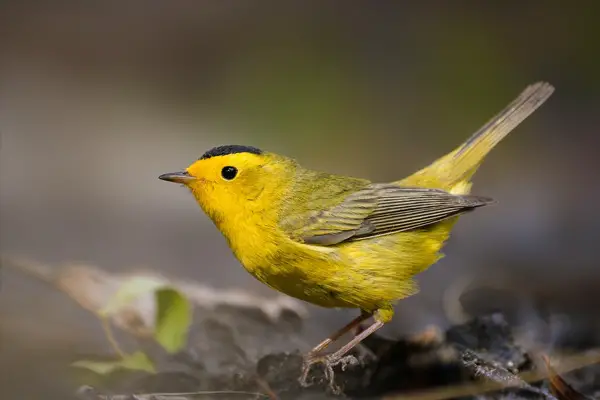
Appearance and Behavior
Wilson’s Warblers have long tails and small bills. They are good at finding food in dense shrubs. This makes them hard to see, but exciting to spot.
Their colors change depending on where they live. Western ones are brighter yellow, while eastern ones are paler.
Nesting Habits
Wilson’s Warblers like to nest on the ground, hidden in shrubs. This helps them avoid predators. But in coastal California and Oregon, some build nests up to five feet high.
This shows they can adapt to different places. They mostly breed in the far north. Those migrating through the southwestern U.S. are usually the last to go to Alaska.
4. American Yellow Warbler
The American Yellow Warbler, known as Setophaga petechia, is a joy to see in the United States. It has bright lemon-yellow feathers and chestnut streaks on its chest. You can find it in wet forests, near willows, cottonwoods, and alders.
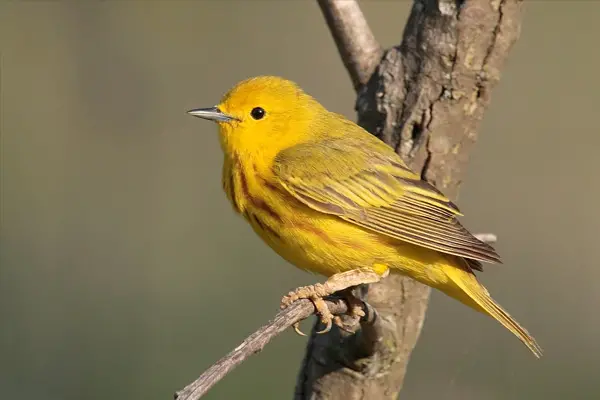
It’s easy to tell males from females. Males have more chestnut markings. Females have a yellowish-green back and crown.
Identification and Characteristics
The American Yellow Warbler is small, with a length of 4.7 to 5.1 inches. Its wingspan is 6.3 to 7.9 inches. It’s not just pretty; it’s also important in its ecosystem.
Its songs are soft and cheerful. Birdwatchers love to hear them. This bird migrates long distances, going from the north to Central and northern South America for winter.
Feeding Preferences
Setophaga petechia eats mostly insects. You might see them looking for midges, caterpillars, and beetles. Watching them eat shows how they fit into their homes.
Birdwatchers can try making sounds like insects. This might help them see the American Yellow Warbler up close.
5. Yellow-Rumped Warbler
The Yellow-Rumped Warbler, known as Setophaga coronata, is a bird with many interesting traits. It is known for being adaptable and stands out among other birds. Its diet and looks are unique.

Physical Description
Seeing a Yellow-Rumped Warbler for the first time is unforgettable. It’s big for a warbler, like a Black-capped Chickadee. It has a big body, a large head, strong bill, and a long tail.
There are two types: the “Myrtle” Warbler and “Audubon’s” Warbler. Each has its own look.
- The “Myrtle” Warbler has a white throat, yellow rump, and yellow sides.
- Audubon’s Warbler has a yellow throat and rump, with yellow sides too.
Females have brownish colors with yellow sides. They also have different throat colors. In places like the Canadian Rockies, you might see birds with mixed colors.
Dietary Habits
The Yellow-Rumped Warbler eats a lot of insects in the summer. It looks for food in trees. In winter, it eats berries, especially bayberries and wax myrtles.
This helps it survive in cold places, even as far as Newfoundland.
| Subspecies | Characteristics | Diet |
|---|---|---|
| Myrtle Warbler | White throat, yellow patches, yellow rump | Insects in summer; berries in winter |
| Audubon’s Warbler | Yellow throat, yellow patches, yellow rump | Insects in summer; berries in winter |
| Intermediate Forms | Unique seasonal color patterns | Insects in summer; various berries in winter |
In the fall, Yellow-Rumped Warblers come together in huge numbers. This shows their amazing migration and adaptability. Learning about these traits helps us appreciate these birds more.
6. Nashville Warbler
The Nashville Warbler, known as Leiothlypis ruficapilla, is a delight for birdwatchers. It has a bright yellow belly and grey back. You might see it in woodlands during migration, where it joins other birds.
Unique Features
This bird is small, about 11 to 13 cm long and weighs 7 to 11 grams. It’s special because it uses porcupine quills for its nest. Its colors are beautiful, but its way of eating aphids on willow leaves shows its habitat’s balance.
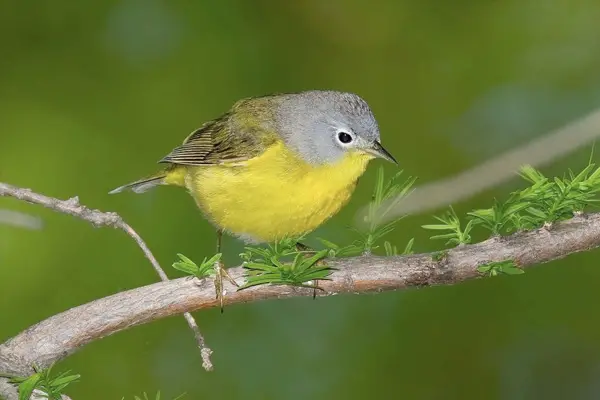
Migration and Habitat
This warbler likes young forests and shrubby areas. It was seen in Denver in January, showing it can adapt. As winter comes, it gets ready to migrate, playing a key role in its ecosystem.
7. Evening Grosbeak
Seeing an Evening Grosbeak is a joy for bird lovers in Colorado. This bird is known for its bright yellow feathers and black and white wings. Its scientific name, Coccothraustes vespertinus, shows its special traits and ways.
Identifying Characteristics
The Evening Grosbeak is a medium-sized bird, about seven to nine inches long. It has a strong bill to crack seeds easily. These birds often visit backyard feeders, especially in winter.

Feeding Behavior
Evening Grosbeaks eat a lot of seeds, up to 20 sunflower seeds a minute. They like seeds, fruits, and insects too. They eat more because of bird feeders, and can be seen in more places.
| Characteristic | Details |
|---|---|
| Size | 7 to 9 inches long |
| Coloration | Bright yellow body with black and white wing patches |
| Bill Type | Robust, ideal for cracking seeds |
| Feeding Rate | Up to 20 sunflower seeds per minute |
| Habitat | Mixed coniferous forests, often near feeders in winter |
Evening Grosbeaks are a treasure in Colorado’s bird world. Their bright colors make birdwatching there even more special.
8. Yellow-Breasted Chat
The Yellow-Breasted Chat is a special bird from North America. It has an olive-grey back and a bright yellow breast. This makes it a favourite among bird lovers and nature fans.
Learning about this bird’s looks and sounds makes birdwatching in Colorado even better.

Distinctive Features
This bird has some cool features that help you spot it easily. The Yellow-Breasted Chat has:
- Colourful plumage: Its olive-grey back and yellow belly make it stand out.
- Size and shape: It’s a medium-sized bird with a big body and long tail.
- Complex vocalization: Its songs are varied and complex, adding music to the forest.
In spring, its songs get louder. You can hear them in thickets and bushes, making everything happier.
This bird likes to live in dense bushes and shrubs. It’s safe there and has plenty of food. Seeing the Yellow-Breasted Chat in the wild is a treat for birdwatchers in Colorado.
9. Magnolia Warbler
The Magnolia Warbler, known as Setophaga magnolia, is a beautiful bird to see. It has bright yellow underparts and black stripes. This makes it easy to spot. Males show off their bright colours in the summer. Females are less bright but still very pretty.

Identification Tips
To spot a Magnolia Warbler, look for these things:
- Colouration: It has a bright yellow belly and a streaked back.
- Size: It’s small, about 4.5 to 5 inches long.
- Habitat: You’ll find it in the underbrush, especially in forests.
- Call: It sings a sweet song that helps you find it.
Migration Patterns
The Magnolia Warbler migrates a lot. It goes from the Caribbean and Mexico to the northern U.S. in the spring and fall. In the summer, it’s in Colorado. You can see it foraging on the ground, which is a great chance to see it.
| Season | Location | Behavior |
|---|---|---|
| Winter | Caribbean and Mexico | Roaming in dense vegetation |
| Spring | Northern U.S. (including Colorado) | Nesting and foraging |
| Summer | Breeding grounds | Foraging in underbrush |
| Fall | Returning to wintering grounds | Migration in flocks |
10. Yellow-Headed Blackbird
The Yellow-Headed Blackbird, known as Xanthocephalus xanthocephalus, has a bright yellow head and black body. Seeing this bird in nature is exciting for bird lovers. They get to see its special looks and actions.
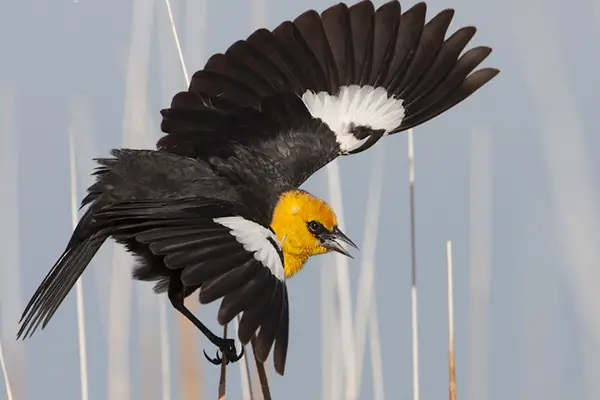
Physical Traits
Males of the Yellow-Headed Blackbird are easy to spot because of their bright yellow head and black body. Females are less noticeable, with a brown body and some yellow. This difference helps them when they breed and nest.
Behaviour and Habitat
The Yellow-Headed Blackbird lives in wetlands with lots of plants like bulrush and cattail. These places are great for building nests. Males show off by singing and calling during breeding season. They are good at finding food in these wetlands, like insects and seeds.
| Attribute | Male Yellow-Headed Blackbird | Female Yellow-Headed Blackbird |
|---|---|---|
| Colouration | Bright yellow head, black body | Brown body with yellow hues |
| Vocalization | Distinct songs and calls | Less vocal, mainly calls |
| Nesting Material | Reeds and emergent vegetation | Reeds and emergent vegetation |
| Behaviour | Territorial and vocal displays | Less territorial, focused on nesting |
11. Western Kingbird
The Western Kingbird, known as Tyrannus verticalis, is a standout in Colorado. It has a bright grey and yellow colour. This makes it easy to spot against a blue sky.
It loves to perch high and scan for food. Its quick movements and sharp hunting skills make it a top insect catcher.

Identification and Coloring
To spot the Western Kingbird, look for these traits:
- Body Color: It’s mostly gray with a yellow belly and undertail.
- Size: It’s about 9 to 10 inches long.
- Bill: Its bill is long and straight, perfect for catching bugs.
- Wings: Its dark wings have white tips, visible when it flies.
This bird’s bright look makes it stand out in open spaces. Birdwatchers love seeing it fly by.
Feeding Techniques
The Western Kingbird has clever ways to catch insects. Here are some:
- Perch-and-dive: It picks a high spot to see prey, then dives to catch it in mid-air.
- Hovering: Sometimes, it hovers to catch small flying bugs.
- Ground Foraging: It also searches for insects on the ground, adding variety to its diet.
The Western Kingbird’s varied hunting methods show its adaptability. This makes it a key part of Colorado’s ecosystems.
12. Common Yellowthroat
The Common Yellowthroat, known as Geothlypis trichas, lives in wetlands in Colorado. It has a bright look and sings a sweet song. Finding it is hard because it blends in well and likes to hide in thick plants.
Knowing how to spot it can make your birdwatching better. This bird is very pretty and fun to see.
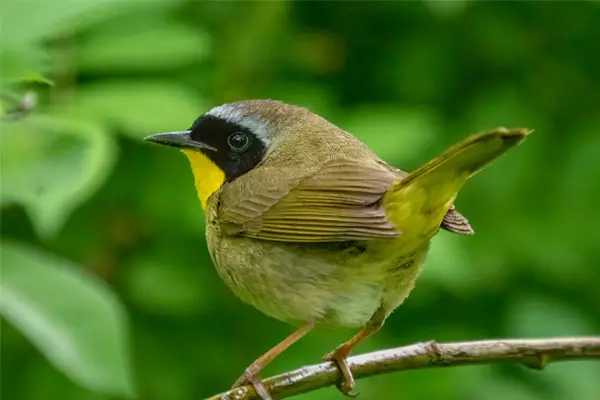
Identifying Characteristics
Here’s what to look for to spot the Common Yellowthroat:
- Colouration: It has a green back and a yellow throat.
- Facial Markings: A black mask around its eyes is very noticeable.
- Size: It’s a small bird, about 5 to 6 inches long.
- Behaviour: It likes to stay hidden in plants.
Its song sounds like “witchety-witchety”. You can hear it in spring and summer. Its song is special because it sounds like other birds. This makes it exciting to find.
It loves places with lots of plants. Knowing how to spot it will make your outdoor time more fun.
Yellow Birds Found in Colorado
Colorado has many yellow birds that birdwatchers love. These birds live in different places, making it fun to watch them. Joining birdwatching groups can make your search for these birds even better. Here are some tips to help you find yellow birds in Colorado.
Diversity and Observation Tips
Exploring Colorado’s nature and birds is exciting. Here are some tips to make your birdwatching better:
- Use binoculars to see birds up close without scaring them away.
- Go to different places like grasslands, rivers, and woodlands. Many yellow birds live here.
- Listen to bird sounds. Birds like the Western Kingbird make unique calls that help you find them.
- Join birdwatching groups or meetups. They can give you more eyes and tips on where to find birds.
- Watch for changes in seasons. Some yellow birds move or change where they live during different times of the year.
By using these tips, you can see amazing yellow birds in Colorado. Look for birds like the Yellow-Breasted Chat or Western Kingbird. Use resources from Colorado Parks and Wildlife to learn about bird numbers and how to help them.
| Bird Species | Habitat | Vocalization |
|---|---|---|
| Western Kingbird | Grasslands, open woodlands | Squeaky, bubbling calls |
| Yellow-Breasted Chat | Stream bottoms, river corridors | Distinctive, melodic notes |
| American Goldfinch | Open fields, gardens | Cheerful, twittering sounds |
| Wilson’s Warbler | Forested areas, shrubby forests | Soft, high-pitched calls |
Conclusion
Exploring yellow birds in Colorado shows us a world full of color and life. The American Goldfinch and Western Tanager are just a few examples. They make our bird world interesting and beautiful.
Learning about these birds makes birdwatching even better. It helps us love nature more. Spotting a Yellow Warbler or hearing a Common Yellowthroat’s song brings happiness.
There are many yellow birds to find in Colorado. Enjoying them gives us special memories and helps protect nature. Joining birdwatching groups and events helps us learn and help the birds.

